Posted by Elena del Valle on January 25, 2010

A mother and her daughter enjoy an embrace
Photo: U.S. Census Bureau, Public Information Office (PIO)
Native born Americans are people who are born in the United States and its territories or born of one or both parents who are United States citizens. Naturalized Americans are foreign born although their children, whether they are born in the United States or abroad, may claim United States citizenship. In 2007, one out of eight residents (38.1 million people out of a total population of 301 million) of the United States was foreign born. In contrast to the last 40 years when most immigrants haled predominantly from Europe, in 2007, 80 percent of all foreign born residents was born in Latin America or Asia.
While the majority of the native born, 78 percent, was White only 46 percent of the foreign born self reported their race as White. The second largest racial group among the foreign born was Asian, 23 percent; and Some Other Race was the final group with 21 percent. Looking at it another way, the race with the highest proportion of foreign born was Asian with 67 percent, followed by Some Other Race (43 percent), and Native Hawaiian and Other Pacific Islander (24 percent).
Foreign born Mexicans represented the largest subgroup among the foreign born (see Mexico remains top country of origin of foreign born); they reported 53 percent White and 45 Some Other Race. That represents a contrast with Cubans which reported 87 percent White; and people born in Vietnam (99 percent), China and Korea (98 percent), the Philippines (97 percent) and India (94 percent) who reported Asian race.
At the same time 47 percent (18 million people) of the foreign born self reported being of Hispanic ethnicity. Among them 54 percent were White and 43 Some Other Race. More than 75 percent of Hispanic foreign born residents were from Mexico and Central America and 83 percent of those were from Mexico originally.
Forty percent of the 45.4 million Hispanics in the United States was foreign born. Among those the percent that is foreign born varies depending on the country of origin. For example, 40 percent of Mexicans was foreign born; 61 percent of Cubans was foreign born and 66 percent Salvadoreans was born on foreign land.
This data is based on Race and Hispanic Origin of the Foreign-Born Population in the United States: 2007, a report by Elizabeth M. Grieco of the United States Census Bureau released last week.
“Marketing to Multicultural Kids” audio recording

Michele Valdovinos gives a presentation and participates in an extended Q&A discussion about multicultural children based on a Phoenix Multicultural and Nickelodeon study of 1,300 multicultural children in 16 United States markets.
Find out about
• The Phoenix Multicultural Kids Study
• Relationship between children and their context
• Issues relating to family, technology and media, diversity, buying power, relationships in household, self perception, values, acculturation, cultural heritage, frequency of media activity, income and spending, brand preferences, the American Dream
• How many billions of dollars buying power multicultural kids children have
• Children’s spending attitudes, habits by ethnicity
• How much money a year Hispanic kids have available to spend
• Types of products Hispanic kids buy
Click here for information on “Marketing to Multicultural Kids” audio recording
Posted by Elena del Valle on January 20, 2010
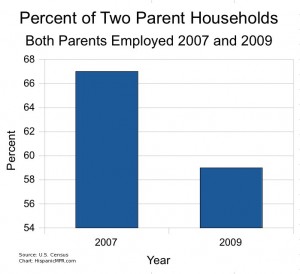
Click on image to enlarge
Between 2007 and 2009 unemployment for couples with children under 18 years of age doubled, according to the United States Census Bureau. Two parent families were more affected than single parent families and Hispanic and black families were also more affected than non Hispanic white families, according to the March 2009 Current Population Survey. While in 2007 in 67 percent of households with a married couple both parents worked by 2009 only 59 percent of those households had both parents working.
In homes with married couples and children 6 percent of husbands and 4 percent of wives were unemployed last year compared to 3 percent of husbands and 2 percent of wives two years earlier. Children living with two parents varied greatly by ethnicity with Asian children being the most likely to live in a dual parent home, 85 percent. Among non Hispanic whites 78 percent of children lived with both parents while 69 percent of Hispanics and 38 percent of blacks shared that type of home.
At the same time, the number of interracial and mixed ethnicity marriages increased. Last year, in 7.6 percent of couples the husband and wife were of different races or a Hispanic was married to a non Hispanic. In 2003, the percent of such marriages was 6.4.
“Segmentation by Level of Acculturation” audio recording

Presenter Miguel Gomez Winebrenner
Discusses
- Assimilation versus acculturation
- Factors that affect Latino acculturation
- How to know if someone is acculturated
- Number of years necessary for acculturation
- Effects of immigration debate on acculturation
- Three main ways of segmenting Latinos
Click here for details about “Segmentation by Level of Acculturation”
Posted by Elena del Valle on January 13, 2010
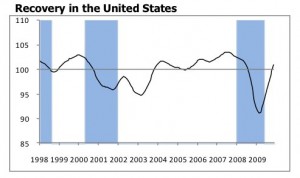
Click on image to enlarge
Graphic: Organization for Economic Co-operation and Development (OECD)
With an additional 85,000 jobs lost in the United States last month there is no doubt that joblessness has become the leading and most serious indicator of our nation’s economic crisis. According to a recent The New York Times article, as of December 2009 most unemployed Americans remain in that state for 29 weeks, the longest since the government began tracking that data in 1948. In order just to keep pace with new arrivals into the workforce the country needs 100,000 new jobs a month. There simply are not enough jobs. Worst of all there is no prospect of enough new jobs developing anytime soon. Are things getting better elsewhere?
At the end of last week the Organization for Economic Co-operation and Development (OECD) which tracks changes in 29 countries announced its composite leading indicators or CLIs for November 2009 point to “stronger signals for recovery than last month’s assessment.” Researchers calculated CLIs for 29 OECD countries and 9 zones.
Analysts at the Paris-based organization interpret the new data to indicate an upward movement in the index of industrial production for the seven countries they examined, except Canada and the United Kingdom. The release also indicates that the CLIs for those major seven countries (Canada, France, Germany, Italy, Japan, United Kingdom and United States) moved above their long-term trend, indicating “an expansionary outlook relative to trend.” The organization’s data for major non member countries economies points to a recovery.
Specifically, the CLI for the OECD area increased by 1.0 point in November 2009 and was 8.2 points higher than in November 2008. The CLI for the United States increased by 1.0 point in November, 6.8 points higher than a year earlier. The Euro area’s CLI increased by 1.1 point in November, 10.9 points higher than a year ago. The CLI for Japan increased by 1.2 point in November, 5.4 points higher than a year ago.
The CLI for the United Kingdom increased by 1.2 point in November 2009, 10.7 points higher than a year ago. The CLI for Canada increased by 1.0 point in November, 9.4 points higher than a year ago. The CLI for France increased by 1.2 point in November, 11.9 points higher than a year ago. The CLI for Germany increased by 1.4 points in November, 12.3 points higher than a year ago. The CLI for Italy increased by 0.9 point in November, 13.8 points higher than a year ago.
The CLI for China increased 0.2 point in November 2009, 7.6 points higher than a year ago. The CLI for India is remained the same in November and 4.3 points higher than a year ago. The CLI for Russia increased by 1.0 point in November, 3.4 points higher than a year ago. The CLI for Brazil increased by 0.8 point in November, 1.3 points lower than a year ago.
What these numbers mean to everyday people in practical terms is anyone’s guess. For now, it seems to offer a small glimmer of hope that the famous V shape of the economic trend is moving up and away from the bottom in some countries.
OECD provides a forum for member governments to compare policy experiences, “seek answers to common problems, identify good practice and coordinate domestic and international policies.” The OECD-Total covers 29 countries: Australia, Austria, Belgium, Canada, Czech Republic, Denmark, Finland, France, Germany, Greece, Hungary, Ireland, Italy, Japan, Korea, Luxembourg, Mexico, Netherlands, New Zealand, Norway, Poland, Portugal, Slovak Republic, Spain, Sweden, Switzerland, Turkey, United Kingdom, and United States. The Euro area (only Euro area countries that are members of OECD) covers 13 countries: Austria, Belgium, Finland, France, Germany, Greece, Italy, Ireland, Luxembourg, the Netherlands, Portugal, Slovak Republic and Spain. The Major Five Asia area covers China, India, Indonesia, Japan and Korea.
Posted by Elena del Valle on January 11, 2010

Chocolate brownie, dark chocolate tablets and cocoa powder
Photos: Simon & Baker, National Confectioners Association
When I think of chocolate my mouth waters. I, like millions of people around the world, especially in the West, think this derivative of the cocoa bean delicious. It is interesting to note that western nations seem to be the most fond of chocolate. While 85 percent of cocoa is imported from West Africa 70 percent of the profit from chocolate sales is made in western countries; and 80 percent of the chocolate market is controlled by only six companies such as Nestle, Mars and Cadbury, according to the World Atlas of Chocolate website.
Could weather play a role? According to Chocolate.org, chocolate is consumed by more people in the winter than in other seasons. This might explain why 16 of the top 20 chocolate consumers are European; they are said to eat 40 percent of the chocolate produced. In the United States, sales of chocolates are more or less even nationally with the exception of the southern states in summer where sales drop slightly. Peak chocolate periods, as might be expected, are Valentine’s Day, Christmas, Halloween and Easter.
In 2009, in spite of the economic hardships faced by so many people across international boundaries, chocolate sales increased. Perhaps not unexpectedly chocolate candy sales in China and the Ukraine rose 18 percent and 12 percent, respectively. Both countries have exhibited steady sales increases since 2005 and some market researchers believe the growth will continue through 2013.
“It’s clear that despite economic trouble this year, the world’s chocolate lovers didn’t deviate from their favorite treat. Chocolate is a small, affordable indulgence for shoppers who are cutting back on spending elsewhere. Even in countries not known for chocolate consumption, sales are on the rise,” said Marcia Mogelonsky, global food and drink analyst at Mintel, an international supplier of consumer, product and media intelligence.

Chocolate truffles
Last year, in Great Britain chocolate sales grew 5.9 percent while in the United States there was an increase of 2.6 percent in chocolate sales compared to 2008. Chocolate sales in Argentina rose 1.8 percent from the previous year; and sales of the brown treats went up 3.2 percent in Belgium. The sales increase in the United States may be the result of inflation, population growth, and new product development, according to Susan Whiteside, spokesperson for the National Confectioners Association, a trade organization dedicated to “advancing and promoting the interests of the confectionery industry and its consumers.”
“We agree with the Mintel findings that chocolate sales in the United States increased (last year). Sales for the period ending November 1 (2009) increased 2.8 percent while unit sales dropped slightly,” said Whiteside, who explained by phone that a 1 to 3 percent annual total revenue increase is normal in this market regardless of what may be happening in the economy.
Perhaps people concerned, depressed, anxious or just waiting to see how and when international economic woes will settle down are turning to chocolate for solace. To take advantage of the trend chocolate makers offered the same or a greater number of chocolate products in 2009 compared to 2008. According to the Mintel Global New Products Database (GNPD), in Latin America, Asia, the Middle East and Africa, companies released more new products than they did in 2008.
Swiss shoppers spend the most for chocolate per person per year, spending the equivalent of $206. Belgians and Brits spend $90 and $106. Consumption of chocolate in the Americas is more moderate with individuals in the United States spending $55 each, and Argentinians buying an average of $35 per year of chocolate candy.
While revenue from chocolate sales in the United States increased the actual number of chocolate products sold decreased (the difference was made up by an increase in the price of chocolates), according to Whiteside. Perhaps because of the price increases representatives from United States chocolate makers Hershey’s (who also make Cadbury in the United States), Nestle’s and Ghirardelli did not reply to email and telephone request for comment.
According to a July 2008 Mintel survey, 78 percent of respondents to a United States survey buy chocolate for themselves and 47 percent bought the sweet treat for others in the past year. The most common reason (two thirds of respondents) they gave for purchasing chocolate was because they had a craving. Two thirds of respondents bought dark chocolate, half bought premium brand chocolate, 16 percent bought sugar-free and 13 percent purchased organic chocolate.
In recent years Americans have been purchasing an ever growing number of premium chocolate products from brands like Ghirardelli, Ferraro and Lindt. In the United States, consumers prefer milk chocolate but their preference for dark chocolate is increasing. This change in the market might be explained by the aging adult population’s preference for stronger flavors, according to Whitewise.
Target Latinos effectively by understanding how they shop
“Hispanic Holiday Shopping Patterns” audio recording

Manuel Delgado, CEO Agua Marketing, gives a presentation and participates in an extended Q&A discussion about
- Hispanic shopping patterns national survey
- Why Latino consumers may be more desirable than general market shoppers
- Hispanics holiday shopping patterns and behaviors
Click here for information on “Hispanic Holiday Shopping Patterns” audio recording
Posted by Elena del Valle on January 6, 2010
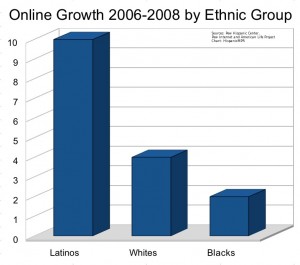
Click on image to enlarge
While broadband internet access from home increased among whites, blacks and Hispanics, Latinos showed the most significant increase in internet use from 2006 to 2008. Although there are fewer Latinos online than whites in 2008, 10 percent more Latinos were online than two years before. Internet use among Latino adults reached 64 percent during that time. That growth outstripped that of whites (4 percent) and black (2 percent) visitors to the internet during the same time period, according to Latinos Online, 2006-2008: Narrowing the Gap, a recent report.
The researchers who authored the report believe the growth was mainly because of an increase in Latinos online who have in the past been absent from the virtual world such as foreign-born Latinos, poorly educated Latinos, and Latinos with an income below $30,000 a year.
They believe that from 2006 to 2008 the increase in the likelihood of having a home connection among internet users was minimal. At the same time, rates of broadband connection increased significantly for Hispanics, whites and blacks. In 2006, 63 percent of Hispanics with home internet access had a broadband connection; in 2008, 76 percent had broadband access. Whites with a broadband connection went from 65 percent to 82 percent, a 17 percentage point increase, and black access to broadband went from 63 percent in 2006 to 78 percent in 2008.
The authors of Latinos Online are Gretchen Livingston, senior researcher, Pew Hispanic Center; Kim Parker, senior researcher, Pew Social and Demographic Trends Project; and Susannah Fox, associate director, Pew Internet and American Life Project.
They derived their findings from a compilation of eight landline telephone surveys conducted by the Pew Hispanic Center and the Pew Internet and American Life Project from February to October 2006, and from August to December 2008. The Pew Hispanic Center surveyed 7,554 adults, and the Pew Internet and American Life Project interviewed 13,687 adults.
Founded in 2001, the Pew Hispanic Center is a nonpartisan research organization that seeks to improve understanding of the U.S. Hispanic population and to chronicle Latinos’ growing impact on the nation. The Pew Internet Project conducts original research that explores the impact of the internet on children, families, communities, the work place, schools, health care and civic/political life.
Reach Hispanics online today with
“Marketing to Hispanics Online” audio recording
Identifying and characterizing the booming Hispanic online market



Joel Bary, Alex Carvallo and Matias Perel
Find out about
• The 16 million Latino online users
• Latino online users by gender
• What they do online
• Their language preferences
• How to reach Hispanic urban youth online
• What affects their online behavior
• What influences their purchases
Click here for information about “Marketing to Hispanics Online”
Posted by Elena del Valle on December 28, 2009

Dave Isay, founder and president, StoryCorps
Photos: Griot Initiative
Are you Hispanic and living in a city the United States or Puerto Rico? Are you comfortable with the idea of an audio recording? Is there a past experience you yearn to share with a friend and others you may never meet? If you answered yes to all these questions, you may want to participate in StoryCorps Historias, an ongoing national program for Latinos developed by Dave Isay of StoryCorps and funded by the Corporation for Public Broadcasting (CPB). The program, launched in New York City September 2009, will be in Miami, Florida January 7-30, 2010.
Part of the program’s outreach is done by partnering with local radio stations, cultural institutions and community-based organizations to collect recordings from 21 locations. In Miami, StoryCorps is partnering with WDNA-FM 88.9 Public Radio, which plans to air some of the local stories. Selected interviews will also air on Latino USA, an English-language news program broadcast in 31 states and NPR’s Morning Edition.

Maggie Pelleyá, general manager of WDNA-FM 88.9 Public Radio
“Miami is the gateway to the Caribbean as well as Central and South America, and everyone has a story of how they arrived here, how they work, how they raise their families, and how they consider Miami their home,” said Maggie Pelleyá, general manager of WDNA-FM 88.9 Public Radio. “WDNA is proud to host this opportunity to share the stories of many who consider Miami as the Magic City.”
According to a StoryCorps representative, participants are free to discuss anything they like, in English or Spanish, such as a favorite memory or important life questions. The StoryCorps Historias website lists some ideas and suggested questions for those seeking inspiration.
“StoryCorps reminds us of our shared humanity; by listening to our stories, we walk in the shoes of others and recognize how much we have in common,” said Isay, founder and president, StoryCorps in a press release about the upcoming Miami program. “We are proud to work with WDNA to help create a growing portrait of our nation’s fastest-growing minority group by preserving the stories of Latinos throughout the country.”
As part of the process, each participant, asked to donate $25, receives a broadcast quality copy of his or her recording. The fee will be waived for those who cannot afford to pay. A facilitator assists participants in the recording session. There are two bilingual facilitators in the program.
At the end the organization plans to select 1,000 recordings to collate together. Those recordings selected for broadcast and archiving in the Library of Congress will be edited and shortened with the participants permission. Also involved in the national initiative are Latino Public Radio Consortium, Latino USA and the U.S. Latino and Latina World War II Oral History Project.

A StoryCorps MobileBooth
Residents of San Francisco, California; Eastern Puerto Rico; Taos, New Mexico; Alamosa, Colorado; Austin and Houston, Texas; and Boston, Massachussets already participated in the program this year. In addition to Miami, the Mobile Booth, where the recordings take place, will visit: Yuma and Phoenix, Arizona January 4, 2010; San Juan, Puerto Rico January 20, 2010; Los Angeles, February 8, 2010, and Fresno, March 22, 2010 in California; as well as Washington, DC April 2010; Albuquerque, New Mexico May 17, 2010; Chicago, Illinois May 17, 2010; Brownsville, May, 2010, and San Antonio, June, 2010, in Texas; San Diego, California July, 2010 and Granger, Washington at a date to be determined.
StoryCorps plans to collect 120 stories in Miami. Its MobileBooth will be parked at the Wolfson Campus of Miami Dade County College for four weeks. Details can be found on the organization’s website, StoryCorps.org.
In addition to Historias, StoryCorps has three other initiatives: Griot, designed to preserve the voices, experiences, and life stories of African Americans; Memory Loss Initiative for people affected by memory loss; and 9/11 Initiative to honor and remember the stories of survivors, rescue workers, and others personally affected by September 11.
StoryCorps is an independent non-profit whose mission is to “honor and celebrate one another’s lives through listening.” According to promotional materials, StoryCorps has one of the largest archives of American voices ever created. Each week, StoryCorps broadcasts air on NPR’s Morning Edition. Other funders include The Atlantic Philanthropies, The Ford Foundation, The Annenberg Foundation, and Joe and Carol Reich.
Posted by Elena del Valle on December 16, 2009
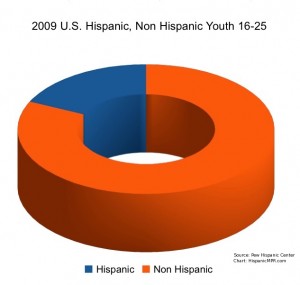
U.S. Hispanic, Non Hispanic Youth – click to enlarge
What’s on Latino youths minds? Why should business people, marketers and mainstream Americans care? According to the Pew Hispanic Center, this is the first time in the history of the United States that a minority ethnic group has represented such a large a share of the youngest Americans. Eighteen percent of people 16 to 25 in America claim Latino ethnicity. These young men and women represent an important part of the future of our country and will continue to do so for years to come since one of every four babies born in the United States today is Hispanic.
A recent Pew survey indicates Latinos 16 to 25 years old believe in the value of education, hard work and a career. These young people have in common a degree of satisfaction with their lives and optimism about their future. At the same time the youths that responded to the survey appear more likely to drop out of school, live in poverty and be teen parents than mainstream youths. The Pew researchers also believe many of these young people are exposed to gangs and live between two cultures. That may not be surprising since the researchers estimate almost one of four (22 percent) Hispanic youths between 16 and 25 are unauthorized immigrants.
The 150-page report, Between Two Worlds: How Latino Youths Come of Age in America, authored by the staff of the center, is based on analysis of government demographic, economic, education and health data sets; a series of focus groups; and a survey conducted between August 2009 and September 2009 among a random national sample of 2,012 Hispanics ages 16 and older, with an oversample of 1,240 Hispanics ages 16 to 25. The survey was conducted in English and Spanish by cellular and land line telephones.
Paul Taylor, director, Pew Hispanic Center wrote the report overview and edited the report. Rakesh Kochhar, associate director for research; Mark Hugo Lopez, associate director; Rich Morin, senior editor of the Pew Research Center’s Social and Demographic Trends project; and Richard Fry, senior research associate, also contributed chapter work to the report.
The report offers a generational analysis of the behaviors, values and experiences of Latino youth who are immigrants themselves (about one-third) and those who are the children and grandchildren (or higher) of immigrants and who responded to the survey.
Two-thirds of Hispanics ages 16 to 25 are native-born Americans. This year marks the first time that so many, 37 percent, of Latinos in this age group are the U.S.-born children of immigrants. An additional 29 percent are of third-or-higher generations while only 34 percent are immigrants themselves. Although Latinos only make up 18 percent of all youths 16 to 25 in the country in some states the percentage of Latinos in that age group is significantly higher: 51 percent of all youths in New Mexico, 42 percent in California, 40 percent in Texas, 36 percent in Arizona, 31 percent in Nevada, 24 percent in Florida and in Colorado.
Survey respondents expressed a strong preference to be identified with their family’s country of origin (52 percent) over American (24 percent) or the terms Hispanic or Latino (20 percent). One third of the U.S.-born children of immigrants identifies first as American and half of the third and higher generation identifies as American first.
The Pew Hispanic Center is a project of the nonpartisan, non-advocacy Pew Research Center. The complete report is available on the organization’s website.
Posted by Elena del Valle on December 15, 2009
An article profiling Elena del Valle, principal LNA World Communications and HispanicMPR editor and host, was published in the October 2009 issue of Somos Magazine for Hispanic Heritage Month. The Spanish language article was written by Luisa M. Fournier-Padró and also appears in the online edition of the publication at Somosonline.com.
Posted by Elena del Valle on December 9, 2009

Angel Gurría, secretary-general, OECD
Photo: Organization for Economic Co-operation and Development (OECD)
In spite of the recent talk of job related improvements, millions of Americans have suffered the ill effects of unemployment. Teenagers have been hit especially hard. For example, in November 2009, more than 25 percent of 16 to 19 year-old Americans were unemployed compared to ten percent for all workers. This is said to be the highest rate of teenage unemployment in the U.S. since World War II.
According to Jobs for Youth: United States, a 170-page report released this month by the Organization for Economic Co-operation and Development (OECD), in the year to November 2009, the youth unemployment rate in the United States rose by 8 percentage points to 19 percent representing an additional 1.6 million young people out of work.
“The short-term priority must be to help the young people most at risk to avoid the long-term scarring of a generation of young Americans,” said Angel Gurría, secretary-general, OECD in a news release. “Business must play its part in creating jobs but the government has to act quickly to extend financial support to more young people and increase funding for re-employment programmes. Longer-term, investing more in education to give young people the skills they need to succeed is essential.”
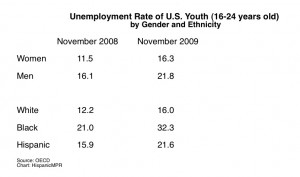
Unemployment in U.S. Youth 2008-2009 – click to enlarge
As recently as 2007, the youth employment rate was 53 percent. While not ideal, especially when compared with 60 percent in 2000; the youth unemployment rate, at 11 percent, was about 1 percentage point higher than its 2000 level. The report summary predicts African-American youth, youth with no qualifications and young women are particularly to face increasing challenges.
Jobs for Youth: United States is the latest in a series of OECD reports on youth employment policies that covers 14 countries. OECD provides a forum for member governments to compare policy experiences, “seek answers to common problems, identify good practice and coordinate domestic and international policies.”
Target Latinos effectively by understanding how they shop
“Hispanic Holiday Shopping Patterns” audio recording

Manuel Delgado, CEO Agua Marketing, gives a presentation and participates in an extended Q&A discussion about
- Hispanic shopping patterns national survey
- Why Latino consumers may be more desirable than general market shoppers
- Hispanics holiday shopping patterns and behaviors
Click here for information on “Hispanic Holiday Shopping Patterns” audio recording
Posted by Elena del Valle on December 2, 2009

When my budget is tight I strive to obtain as much as possible for my money. I examine purchases to make sure they offer the best value for money. In doing so I look closely at new and existing vendors. I’m most likely to patronize those vendors that offer the same value I have received in the past. Vendors that offer additional benefits compared to past purchases and existing options are the most likely to receive my business.
I am in good company thanks to the spreading economic crisis. Many, if not most, consumers face the same decision issues today. According to a recent Mintel (“a global supplier of consumer, product and media intelligence”) survey, a majority of shoppers said they always look at sale items before shopping for non-sale items, especially in department stores (64 percent), at mass merchandisers (53 percent) and at discount apparel stores (53 percent). Four in 10 shoppers said they spend a lot of time looking for clothing sales and shopping around for the lowest price.
That is why I find it puzzling and self defeating to see the increasing number of companies that decrease benefits for the same cost. To illustrate I will tell you about a favorite restaurant my husband and I used to visit regularly. Although the food was nothing to write home about for years we stopped there on weekends for a quick bite and to enjoy the stunning and extraordinary waterside setting the historic restaurant offered.
It was a popular restaurant. Often there was a long wait (an hour or more) for a table, longer for the section we liked. As the economy soured the crowed thinned. Now here’s where it gets interesting. As fewer guests came the restaurant management began cutting back on the quality and quantity of the food. The prices remained the same. The cloth napkins were replaced with paper napkins. The yummy Hawaiian bread and warm cornbread had to be requested instead of being brought automatically as in the past. After a while, the nice bread disappeared completely to be replaced with boring buns. The guacamole was excised from the fish tacos plate. It could be ordered for a supplement of $1. The portion size became smaller than ever and the quality of the food diminished. The prices remained the same.
Eventually, and worst of all, the quality of the food dropped so much I couldn’t eat it. For a while we had struggled with the state of the restaurant but kept on going hoping that the management would realize that taking good care of the loyal customers that remained was the best avenue to surviving difficult times. Instead things continued to worsen. After several more disappointing visits we stopped going altogether.
Last week the Air Transport Association predicted holiday traffic would drop 4 percent and others speculated that the drop in air traffic would be ever greater during what is historically one of the busiest travel weeks of the year. It’s no wonder with high unemployment, a deep recession and airline surcharges for holiday travel. It’s bad enough having to travel through crowded often ill designed, uncomfortable airports; and run through the gauntlet of airport safety checks, removing sweaters, belts, shoes, watches, and even jewelry to pass through; sometimes being wanded or patted down by a stranger; and obliging any instruction an arbitrary security agent provides to get from Point A to Point B on an overcrowded airplane (although there are fewer passengers than in past years the airlines have reduced flights leaving remaining flights overcrowded) when there is so much stress in our lives already.
If they want to improve their bottom line and customer loyalty, should airlines be offering better deals and more incentives; and doing everything they can to make it more pleasant and easier than ever for passengers to travel? Are they doing that already? Is adding luggage fees and holiday surcharges producing the results they desire? Are passengers likely to eagerly book when they return from full flights that results in increasingly less comfortable travel experiences?
It seems counter intuitive to raise prices and lower quality and quantity when everyone is cutting back budgets and looking to maximize value for money. And yet that seems to be what so many companies are doing. From a marketing perspective to draw traffic you offer an irresistible product or service or the perception of it. There are many examples of this. A prominent one is the ubiquitous iPhone, and iPod. Thus far Apple has survived, some would even say thrived while so many others have gone the bankrupt.
In the absence of a product the customer can’t resist the vendor can offer good or better value for money to sweeten the deal. Should smart executives increase marketing and public relations budgets to spread the word and remind the public of their brand, product, or service and prompt a purchase as soon as the customer is ready? Instead so many companies are doing the opposite, offering poor or lower quality and lesser value for money than in the past. Why then are they baffled to see their bottom line affected?




























